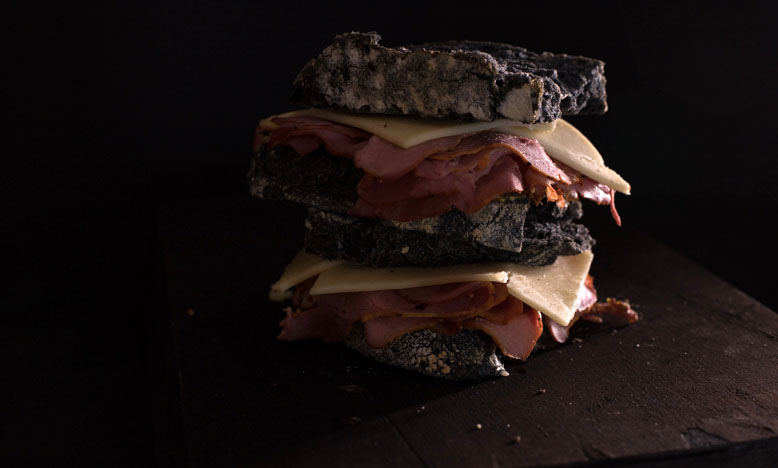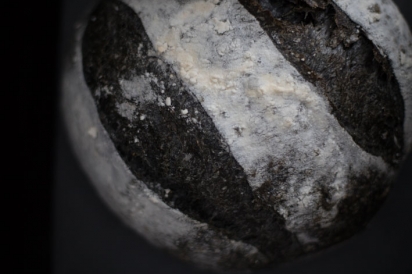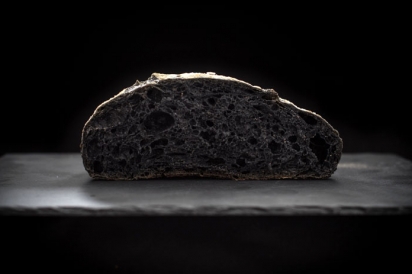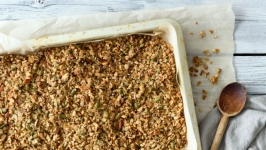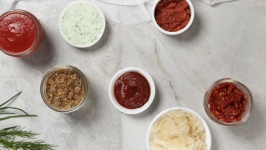Black Charcoal Sourdough Bread with Smoked Meat
Activated charcoal is seeing a surge in popularity of late as the eye-catching darling on social media. From ice cream and lattes, to pizza and bagels — it seems as though everyone is getting in on the action. Charcoal transforms nearly any food to a shade of super-black — a colour not easily attainable by other natural means. It can look stunning on a plate, but taste-wise, it doesn’t add much. But it's not just superficial. Also known as activated carbon, the food-grade, flour-like powder is commonly made by burning coconut shells into ash. Long used in the medical field for treating certain types of overdoses, the powder has received a reputation as a powerful detoxifier. It’s showing up in supplements, smoothies and face-care products, but medical professionals warn against its overuse. Carbon can absorb toxins very well, but isn’t great at parsing out the good from the bad — meaning the benefits of any vitamins or essential minerals could also be removed.
This recipe for a black charcoal sourdough uses charcoal sparingly for dramatic results.
Start with the starter
A simple sourdough starter is easy to make at home but, like many good things, it does take time: A week to cultivate the initial starter, then a few days' lead time to make bread or other baked goods using what you’ve grown. But once you taste the baked results, you’ll know the investment of time was worth it.
It begins with a community of yeasts and bacteria that make a “culture,” creating air bubbles, acidic smells and a symbiosis of living organisms particular to sourdough starters. Without too much effort, you can draw these yeasts and bacteria into your kitchen (you want them there) and keep them alive. Breads leavened with sourdough starter are more digestible, with less gluten present after they have fermented. They also have more nutrients than breads risen with commercial yeast.
Sourdough starter
Black Sourdough Bread 11/2 tablespoons activated charcoal* 3½ cups bread flour, plus more for work surface ¼ cup active sourdough starter (proofed and bubbly) 1½ cups water, room temperature 2 teaspoons sea salt Olive oil *If using your own sourdough recipe, use approximately 3 tablespoons of activated charcoal per kilogram of flour. Using a stand mixer fitted with a dough hook attachment, combine flour, sourdough starter, water and salt on medium-low speed (or stirring by hand) until a ball of dough forms that cleans sides of bowl, about three minutes. Place dough into large, oiled mixing bowl and cover tightly with plastic wrap. Let rise in a warm spot in your kitchen until doubled in bulk, 8 to 12 hours. Place a cast-iron or enamel Dutch oven in oven, and heat to 450F. Turn dough onto floured work surface and gently form into a boule. Cover with plastic wrap and allow to rise for 30 minutes. Uncover your dough and re-form it, if necessary. Place your dough into pre-heated Dutch oven and cover with lid. Bake for 30 minutes, remove lid and continue baking until bread is browned, about 15 minutes. Allow to cool completely before slicing and serving. Enjoy with your favourite pastrami, grainy mustard and cheese
1 5-lb. bag of all-purpose flour
1 5-lb. bag of wholewheat flour
water (ideally non-chlorinated filtered water)
In a non-reactive container, mix 1 cup of cool water with 1 cup of all-purpose flour and 1 cup wholewheat flour.
Stir until combined, cover loosely with cloth or the lid to your jar and leave it in a warm location (about 70F).
Let your starter sit for 24 hours. Sourdough starter is very temperature sensitive, so if you are starting in the winter this process could take much longer if you don’t have a warm spot in the house. If you are starting in the summer, place it in a shady spot where it won’t get too hot.
Discard roughly half of your mixture and add another cup of cool water, 1 cup of all-purpose and 1 cup whole-wheat flours to what is left in your container. Stir until combined.
Repeat this step of feeding your starter every day for the next week at approximately the same time each day. Keep watch for bubbles, air pockets and a slightly acidic smell as your starter captures the wild yeast and bacteria and they begin to feed on the complex sugars in the flour and release carbon dioxide in the process.
When your starter returns to the same level of bubbly activity multiple days in a row, you have done it. Either give your new culture a fresh feed of flour and water then place it in the fridge for future use or get baking.
Making your own sourdough starter could take more than a week, so be patient and keep repeating the steps.
Black Sourdough Bread
11/2 tablespoons activated charcoal*
3½ cups bread flour, plus more for work surface
¼ cup active sourdough starter (proofed and bubbly)
1½ cups water, room temperature
2 teaspoons sea salt
Olive oil
*If using your own sourdough recipe, use approximately 3 tablespoons of activated charcoal per kilogram of flour.
Using a stand mixer fitted with a dough hook attachment, combine flour, sourdough starter, water and salt on medium-low speed (or stirring by hand) until a ball of dough forms that cleans sides of bowl, about three minutes.
Place dough into large, oiled mixing bowl and cover tightly with plastic wrap. Let rise in a warm spot in your kitchen until doubled in bulk, 8 to 12 hours.
Place a cast-iron or enamel Dutch oven in oven, and heat to 450F.
Turn dough onto floured work surface and gently form into a boule. Cover with plastic wrap and allow to rise for 30 minutes.
Uncover your dough and re-form it, if necessary. Place your dough into pre-heated Dutch oven and cover with lid. Bake for 30 minutes, remove lid and continue baking until bread is browned, about 15 minutes.
Allow to cool completely before slicing and serving. Enjoy with your favourite pastrami, grainy mustard and cheese.


